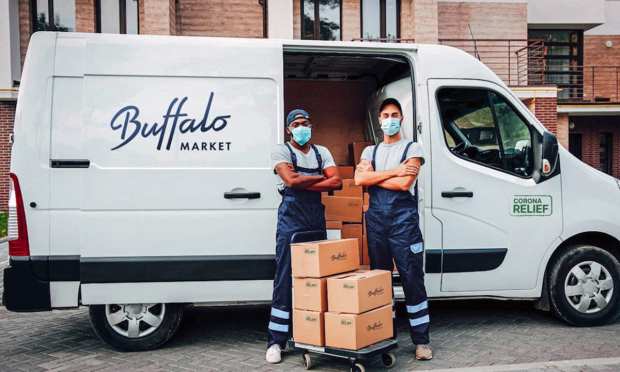Buffalo Market’s ‘Restaurant Bridge’ Initiative Supports Customers Amid Difficult Year

With the restaurant industry hit hard by the events of the last year and small and midsize businesses (SMBs) disproportionately bearing the brunt of these challenges, consumers and businesses alike are eager to show their support for small restaurants, however possible. For the former, this can mean dining at their favorite local eatery as soon as their stimulus checks hit their bank accounts. For businesses, it can mean offering anything from software solutions to marketing support for free or at discounted rates. For online wholesale grocer Buffalo Market, supporting restaurants means offering six-month lines of credit without fees with Restaurant Bridge: A Covid Relief Program.
“Restaurants have been struggling to hold on, to keep their employees working, to keep feeding the neighborhoods they operate in … and if we don’t support them with actual money, they’re not going to pull out of this,” Buffalo Market Co-founder Sean Howell told PYMNTS in a recent interview. “Buffalo Market is giving these businesses the actual cash they need to pull out of this with … a no-fee program to access what [they need to keep] their businesses going.”
The program seeks to extend these lines of credit to more than 1,000 restaurants in its home state of California, and the application period runs through April 17.
Buffalo Market’s Mid-Pandemic Launch
The company is especially sensitive to the issues facing restaurants during the pandemic given its own unique circumstances — Buffalo Market launched its digital marketplace in October, meaning that it has been facing the challenges of the coronavirus crisis since day one.
“What is similar is that our workers have added risks because of the pandemic, and we need to take extra precautions,” said Howell, adding that there were some issues that were unique to the grocery industry. “…One of [our] biggest challenges was keeping meats, produce, et cetera, in stock. Many of these businesses faced temporary closures and other constraints. We bent over backward, sending our own trucks to suppliers to pick up goods, [and] even servicing other grocery stores … to help our suppliers get their products where they needed to go.”
Meanwhile, the company’s local-oriented mindset and its delivery-centric model benefitted during the mid-pandemic launch, with consumers’ increased focus both on supporting local businesses and on contact-free convenience. Additionally, the company looks to diminish food waste by shipping out food to businesses after consumers have ordered in advance so that the company will know the exact amount required, a valuable model for appealing to sustainability-minded shoppers.
Working In Partnership
It may seem odd for a grocer to be extending lines of credit to restaurants, a service typically provided by banks, the federal government or restaurant financiers. Yes, some major companies, such as Discover, Uber Eats and Grubhub, among others, have offered their own restaurant grant programs, but for a company less in the public eye, the Restaurant Bridge program is not necessarily an intuitive move at first.
However, Howell notes that Buffalo Market relies on restaurants, and small restaurants have especially been key to the company. Amid the supply chain disruptions of the pandemic, he noted, “Some of the big players simply couldn’t service their small restaurant owners, and this fueled new growth for us.”
Howell calls restaurants the company’s “best customers,” adding that restaurants “have had a far worse time during COVID” than grocers have.
“They have had drops in revenue and increased costs,” said Howell. “…We continue to see our restaurant customers struggling to adapt fast enough. As the pandemic ends, this won’t simply mean the restaurants bounce back. Many have been robbing Peter to pay Paul and sacrificing a lot to keep their businesses going.”
Looking Ahead
One year from now, Howell predicts, “I suspect it will be an exciting time for upcoming chefs to try their hands at filling the vacancies in restaurants that closed, and it may be one of the most innovative times in food.”
One of the innovations he expects we will see in the restaurant industry is an explosion of ghost and cloud kitchen technology, even beyond the mass adoption of these solutions that we have already seen.
“These are a low-risk way for new entrepreneurs and experimenters to enter the food business,” he noted. “Venerable restaurants were also forced into this model whether they liked it or not and you see even some [restaurants that] might be considered dinosaurs thriving online, and at least for now adapting to a cloud kitchen model.”
On Buffalo Market’s end, the grocery side of the food industry, Howell noted, “[Grocers] were forced to evolve less than restaurants … Long run, everyone still likes to go to a grocery store from time to time, but this will be less about picking up everyday items and more about experiences groceries stores can offer.”
Specifically, Howell cited cooking classes and in-person demonstrations as examples of the sorts of on-site offerings that can continue to draw customers into stores. For Buffalo Market specifically, the next few years hold both expansions further into the California market and more aid-centric initiatives for local businesses.
“California is a multibillion-dollar market and we are focused on serving it well [and] growing,” he said, “…[and] I think you will see a lot more programs from us to help restaurants thrive and improve the food system for everyone, including consumers.”
